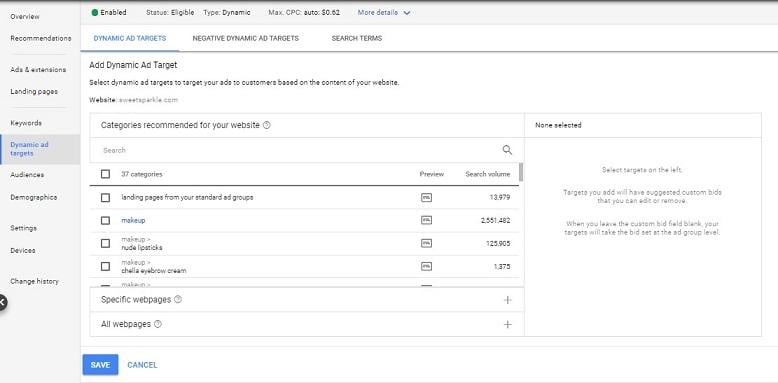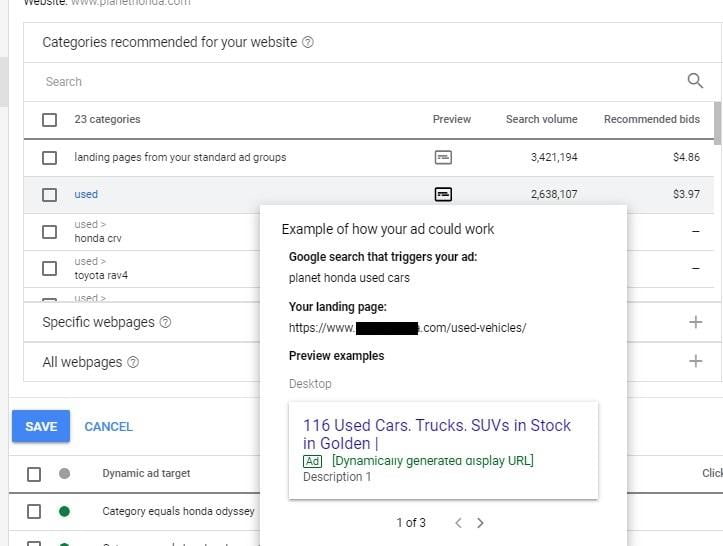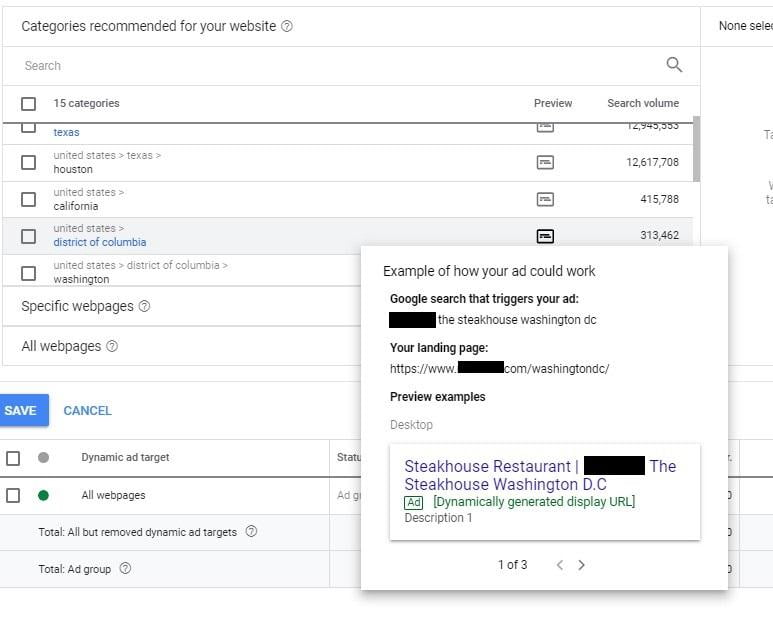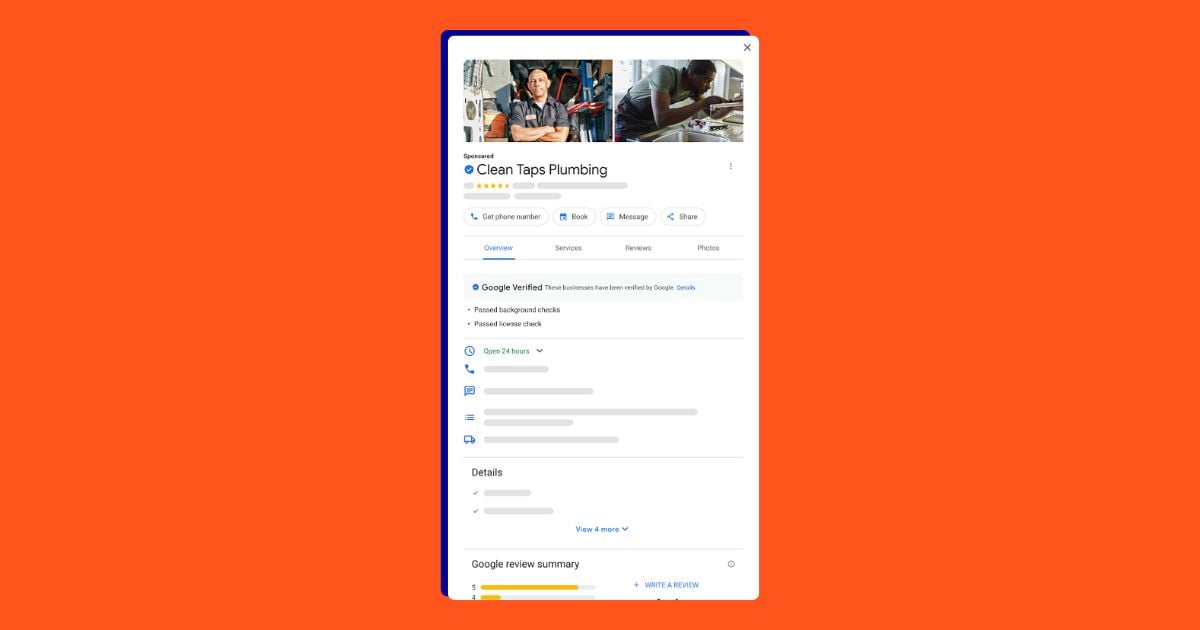
Dynamic Search Ads (DSAs) have the potential for high volume and profit—but they also have the potential for budget cannibalization and waste. Harnessing their powers for good requires planning ahead, establishing clear goals and workflows, as well as knowing when to transition budget to more restrictive strategies.
I’m going to tell you everything you need to know about DSAs:
- What Dynamic Search Ads are
- How Dynamic Search Ads work
- When to avoid Dynamic Search Ads
- When to use Dynamic Search Ads
Let’s get started!
What are Dynamic Search Ads?
Dynamic Search Ads are ads in a campaign type that focuses on sections of a brand’s site, forgoing bidding on keywords. Instead, Google will crawl the site, identify pages that could match the query, populate the headlines with relevant copy, and link to the page.
While setting up DSAs, you can choose to target specific pages, over-arching sections (product groupings, destinations, etc.), or make it a free-for-all.
After you choose the targets, you will be prompted to craft ad copy. DSA descriptions need to be flexible – making them a reasonable use case for dynamic keyword insertion. Some marketers prefer to own the description copy because the headlines are generated by Google.
Where Dynamic Search Ads work—and really well
Dynamic Search Ads are one of the more practical ways to apply AI in marketing. Dynamic Search Ads aren’t going to work for every account. But when they do work, they work really well. Here are a few industries where DSAs can be incredibly successful.
1. Dynamic Search Ads for ecommerce
It’s hard to budget and manage a search account structure that can deliver the same level of granularity shopping campaigns thrive on. DSAs can be a superheroes in this regard!
DSAs allow you to target product groupings before you invest the time in building out your shopping feed and campaign structure. By running DSAs first, you’ll get insights into which products get searched for more often, how well they convert, and what auction price they need to win.
While it’s true you won’t be able to include an image of your product with the ad, you’ll be able to honor more specific queries.
2. Dynamic Search Ads for real estate and auto
If your business has multiple listings, it can be tough to know where to send folks. Many will compromise and add a filter to their search engine with a price tag, feature, or other qualifier. Yet Dynamic Search Ads allow an account to make an even more specific promise, and the landing page can be the perfect property/car to get the conversion.
The value of leveraging DSAs is amplified by the simplification of campaigns and budgets. Unless your business has unlimited budget, your ability to be targeted will be limited. Running DSAs allows all parts of the business to get access to traffic with a single controlled budget.
3. Dynamic Search Ads for local brands or local landing pages
Budget often makes us choose account structure compromises over what would truly serve the account. Local branches of national brands/franchises face this more than any other vertical: Do you set a budget for each location and risk spreading yourself too thin? Or do you lump them all locations together, potentially neglecting certain markets?
DSAs solve that problem by allowing location pages to be a target instead of needing to set an ad group for each location (causing the campaign to have structure issues) or have a campaign per location (increasing the minimum budget needed to support paid efforts).
In addition to consolidating campaigns, DSAs will also teach you how folks search for your services by market.
In all use cases of Dynamic Search Ads, you’ll benefit from keyword harvesting (learning valuable ways your prospects search), which enables smarter keyword planning and campaign structure.
What to avoid with Dynamic Search Ads
DSAs are the ultimate expression of a “data acquisition” strategy—using these ads teaches you how your prospects search, how much those searches cost, and how easy it is for Google to crawl your site.
Sounds awesome, right?
It can be, but there are a few situations that sink the well-intentioned DSA fast:
- Including it in existing campaigns
- Not including exclusions or negatives
- Targeting everything in one ad group
Let’s tackle each of these problem areas, going over why they don’t work and how to avoid them!
Problem #1: Including DSAs in existing campaigns
When Dynamic Search Ads are included in existing campaigns, it opens the door to budget misallocation. The DSAs will be predisposed to get access to budget allocated for proven concepts. This means previous performers can begin to stagnate, as the DSA ad group ramps up and drives up the average cost per click (CPC).
Problem #2: Not applying exclusions or negatives correctly
Even if DSAs are established in their own campaign (which they absolutely should be), there are still risks of waste. Dynamic Search Ads are designed to crawl your site and serve up what appears to be the best answer, which is heavily impacted by search engine optimization (SEO). The home page of any website will be the most optimized, yet it’s rarely where you would want to send traffic (unless it’s a branded campaign). Additionally, blog content, contact pages, and other support elements may be great from an informational standpoint, but these are not predisposed to capture leads and sales. However, because they will have high SEO value, they are likely to spend budget intended for more transactional pages.
dynamic-search-ads-targeting-rules
It is vital to exclude these pages from the DSA campaign. You also need to set all keywords you will be actively bidding on in other campaigns (branded terms included) as exact match negatives. In doing so, you will ensure DSAs can perform their job without sabotaging the other campaigns.
Problem #3: Targeting everything in one ad group
DSAs are the ultimate expression of automation: Google or Bing writes the headlines, picks the landing pages, and often, sets the bids. Yet because we still need to write the descriptions, it’s vital that these are configured for each section we’re running DSAs for.
Different targets will represent different auction prices, and if DSA is teaching you how to build out your shopping campaigns (one of its best use cases), you’ll want to have those auction prices separated so you can set bids and budgets designed to win.
Finally, use Dynamic Search Ads to test SEO
Regardless of the industry, Dynamic Search Ads can be a health indicator for your site’s SEO. If the auto targets that Google pulls up are “off,” you know you have work to do. Review your website, adjust your copy, and make sure that your most compelling information appears central on the page—and in your DSA ads.













